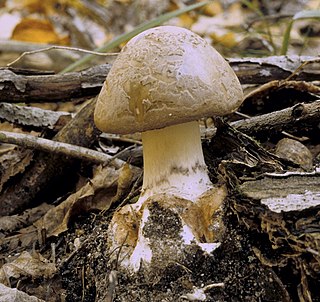
The booted macaque is a macaque of the Sulawesi Island, Indonesia. This Old World monkey is diurnal and spends most of the day in the trees. It is 50–59 cm long plus a tail of 35–40 cm.

Amanita brunnescens, also known as the brown American star-footed amanita or cleft-footed amanita is a native North American mushroom of the large genus Amanita. Originally presumed to be the highly toxic Amanita phalloides by renowned American mycologist Charles Horton Peck, it was described and named by George F. Atkinson of Cornell University. He named it after the fact that it bruised brown. It differs from the death cap by its fragile volva and tendency to bruise brown. It is considered probably poisonous.

The pectoral-patch cisticola is a species of bird in the family Cisticolidae. It is found in Cameroon, Republic of the Congo, Democratic Republic of the Congo, Eritrea, Ethiopia, Gabon, Kenya, Somalia and Tanzania. Its natural habitats are damp or wet areas in upland grassland.

The spotted barbtail is a species of bird in the family Furnariidae. Its natural habitat is subtropical or tropical moist montane forest.

Ionolyce is a small genus of butterflies in the family Lycaenidae. I. helicon is widespread in the Indoaustralasian region (India to the Malay Archipelago. I selkonand I.brunnescens are both endemic to the Solomon Islands.

Amanita aestivalis, commonly known as the white American star-footed amanita, is a species of fungus in the mushroom family Amanitaceae. The fungus is distributed in the eastern United States, south to Florida, and reaches north into the southeastern provinces of Canada. The cap of the fruit body is medium-sized, 5 to 8.5 cm in diameter and white. It sits atop a stem that is 8.5 to 16 cm long and has a rounded bulb at its base. The entire fruit body will slowly stain a reddish-brown color in response to bruising or aging. It remains unknown whether Amanita aestivalis is a distinct species from A. brunnescens, another similar Amanita with a comparable distribution. There are several other white-bodied amanitas with which A. aestivalis may be confused, including A. virosa, A. phalloides, and A. bisporigera.

Hume's bush warbler is a species of bush warbler. It was formerly included in the "Old World warbler" assemblage.
Epilobium brunnescens is a flowering plant belonging to the willowherb genus Epilobium in the family Onagraceae. It is a small, creeping, perennial plant with white or pale pink flowers. It is native to New Zealand and south-east Australia and has been introduced to Northern Europe. Its common names include New Zealand willowherb in Great Britain and Ireland, creeping willowherb in New Zealand and bog willowherb for the Australian subspecies.
Gonystylus brunnescens grows as a tree up to 40 metres (130 ft) tall, with a trunk diameter of up to 100 centimetres (40 in). Bark is reddish to dark brown. Fruit is round, brown, up to 7 centimetres (2.8 in) in diameter. The specific epithet brunnescens is from the Latin meaning "brownish". Its habitat is forest from 40 to 1,500 metres altitude. G. brunnescens is found in Peninsular Malaysia and Borneo.

Carex brunnescens, the brownish sedge or green bog sedge, is a species of plant in the sedge family (Cyperaceae). It has a circumboreal distribution, and is native to North America and Eurasia. In the United States it is primarily found in the Northeast and Midwest extending south into the Appalachian Mountains, with disjunct populations westward in the Rocky Mountains. It has a wide-ranging natural habitat, is in found in forests, bogs, fens, and rock outcrops.

Phaeomolis brunnescens is a moth of the family Erebidae first described by Walter Rothschild in 1909. It is found in Panama, Brazil and Bolivia.

Sybra is a genus of beetles in the family Cerambycidae, containing the following species:
Hypospila brunnescens is a species of moth in the family Erebidae. It is found in Indonesia.
Sybra iconica is a species of beetle in the family Cerambycidae. It was described by Pascoe in 1865. It contains two subspecies, Sybra iconica clarevitticollis and Sybra iconica iconica.

Sybra umbratica is a species of beetle in the family Cerambycidae. It was described by Pascoe in 1865.
Sybra bioculata is a species of beetle in the family Cerambycidae. It was described by Pic in 1925. It contains four subspecies: Sybra bioculata bioculata, Sybra bioculata quadrinotata, Sybra bioculata sikkimana, and Sybra bioculata tigrina.
Sybra mimogeminata is a species of beetle in the family Cerambycidae. It was described by Breuning and Ohbayashi in 1964. It contains two subspecies, Sybra mimogeminata carinatipennis and Sybra mimogeminata mimogeminata.

Sybra ordinata is a species of beetle in the family Cerambycidae. It was described by Henry Walter Bates in 1873.
Sybra pascoei is a species of beetle in the family Cerambycidae. It was described by Lameere in 1893.
Sybra subfasciata is a species of beetle in the family Cerambycidae. It was described by Henry Walter Bates in 1884.











